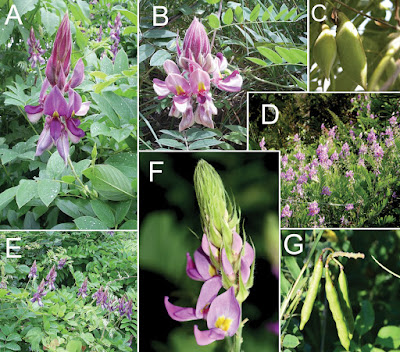 |
Platypelis ando
Scherz, Köhler, Vences & Glaw, 2019
|
Abstract
We describe a new species of arboreal narrow-mouthed frog, genus Platypelis, from Ambodivoangy near Maroantsetra in northeastern Madagascar. The new species, Platypelis ando sp. nov., is characterised by small body size (under 19 mm), a generally rather slender body, yellowish finger and toe tips, and a dark brown dorsal chevron. Its advertisement call is a single, moderately long, high-pitched whistle repeated at regular intervals. It is the sister species of P. ravus from Marojejy National Park, but differs from that species by considerable pairwise genetic distances (7.9%) in a fragment of the mitochondrial 16S rRNA gene, and also in bioacoustic and morphological features, especially the absence of yellow on the posterior abdomen. It is also surprisingly similar in external appearance to Cophyla occultans and C. maharipeo, to which it is not, however, closely related; these species are most easily discerned based on their calls. Platypelis ando sp. nov. joins the ranks of several species recently described from Ambodivoangy with close affiliations to species in the nearby Marojejy National Park, that are still divergent at species level. The species qualifies as Critically Endangered according to the IUCN Red List criteria, in line with other species recently assessed from this area, but we urge that more research be conducted in the nearby forests to extend the range of this and other species known only from Ambodivoangy.
Key Words: Amphibia, bioacoustics, systematics, taxonomy, morphology, molecular genetics
 |
Platypelis ando sp. nov.
(a–b) Holotype (ZSM 293/2010) in (a) dorsolateral and (b) ventral view;
(c–d) paratype (ZSM 292/2010) in (c) lateral and (d) ventral view. |
Platypelis ando sp. nov.
Diagnosis: The new species is assigned to the genus Platypelis based on molecular phylogenetic relationships (Fig. 1). Platypelis ando sp. nov. is characterised by the following combination of characters: (1) Small size, with adult male SVL 16.9–18.7 mm; (2) manus with second finger shorter than fourth, pes with fifth toe shorter than third; (3) discs of fingers and toes yellowish to orangish in life; (4) presence of a dark dorsal chevron; (5) presence of dorsal tubercles; (6) short supratympanic dark brown marking; (7) males with prepollical tubercle but lacking a finger-like prepollex as typical for Anodonthyla Müller, 1892.
The new species is distinguished from Platypelis cowanii, P. mavomavo, P. grandis, P. tsaratananaensis, P. pollicaris, P. alticola, P. olgae, P. tuberifera, P. barbouri and P. milloti by considerably smaller size (16.9–18.7 vs >25 mm). Among Platypelis species of similar size, it can be distinguished from P. tetra by its smaller dorsal tubercles, absence of large white spots on the dorsum (vs presence), and presence of a brown chevron-shaped marking on the dorsum (vs absence); and from P. karenae by its brown colouration and dorsal patterning (vs yellow colouration and lack of dorsal patterning), short supratympanic dark brown marking (vs extended along the flank), and less pointed snout. Morphologically and genetically, P. ando sp. nov. most closely resembles P. ravus. It differs from that species in the lack of yellowish colour on its venter (vs present), yellowish to orangish dorsal finger and toe tip colouration (vs brownish), and by a chevron-shaped brown marking on dorsum (vs W-shaped).
....
 |
| Figure 2. Platypelis specimens in life. (e–f) holotype (ZSM 349/2005) of P. ravus in (e) dorsolateral and (f) ventral view. |
Natural history: As is typical for Platypelis species, calling activity was only heard after dusk. ZSM 291/2010 was found calling 1.8 m above the ground. Nothing further is known about the habits of this species, but based on the reproductive ecology of congeners, it is likely to reproduce in phytotelms and have endotrophic nidicolous tadpoles.
Available names: Only two available synonyms of any Cophyla or Platypelis refer to small-sized species that could possibly refer to our new species. Cophyla tuberculata Ahl, 1929 ‘1928’ is currently a synonym of P. grandis. The two syntypes are juveniles according to Blommers-Schlösser and Blanc (1991), but have an SVL of 26 mm, and are therefore larger than the new species. Paracophyla tuberculata Millot & Guibé, 1951 is currently considered a synonym of P. barbouri. The holotype of that species, MNHN-RA-1957.715, differs from our new species in having a more rugose dorsum, broader finger discs, and a darker venter. Additionally, it is from Périnet (=Analamazaotra) in the Central East of Madagascar, more than 400 km south of Ambodivoangy. Blommers-Schlösser and Blanc (1991) concluded that it is conspecific with P. barbouri, and we agree that it is a member of that species complex, which is in need of revision.
Etymology: We dedicate this species to our friend and colleague, Dr. Andolalao Rakotoarison, in recognition of her valuable contributions to the systematics and taxonomy of the Malagasy microhylid fauna. The name is to be treated as an invariable noun in the nominative singular.
Distribution: The new species is reliably known only from the type locality Ambodivoangy, but the species is likely to be more widespread in low altitude forest of the adjacent Makira Natural Park. Glaw and Vences (1992) found a small Platypelis species (assigned to and figured as P. occultans) near Voloina (15.5775S, 49.6042S; voucher specimens ZFMK 52777–52779), ca. 30 km south of the type locality with similar calls and morphology, which is possibly conspecific with Platypelis ando, but further studies are necessary to confirm its identity.
Mark D. Scherz, Jörn Köhler, Miguel Vences and Frank Glaw. 2019. A New Yellow-toed
Platypelis Species (Anura, Microhylidae, Cophylinae) from the Maroantsetra Region, northeastern Madagascar.
Evolutionary Systematics. 3(1): 75-83. DOI:
10.3897/evolsyst..33417










































